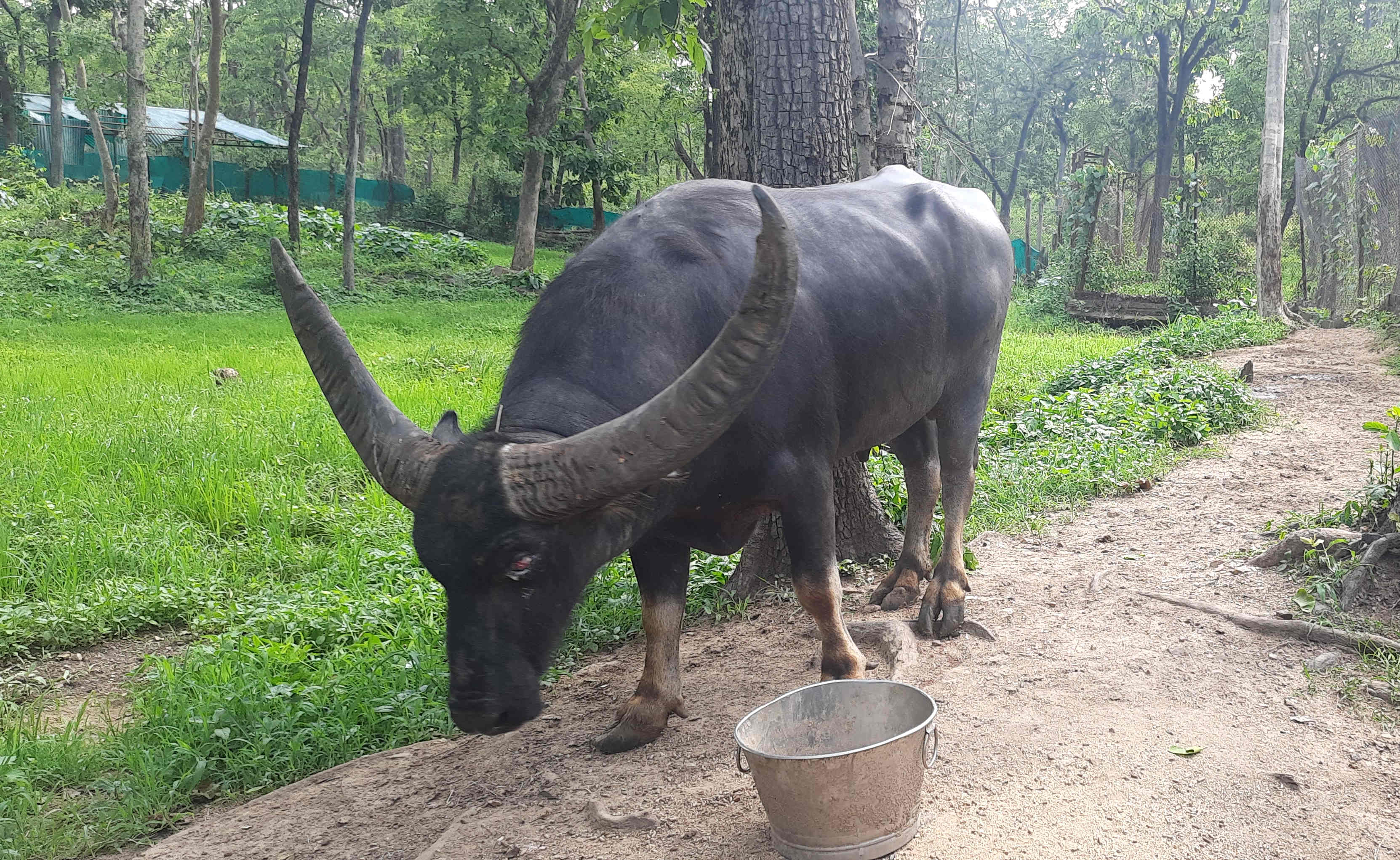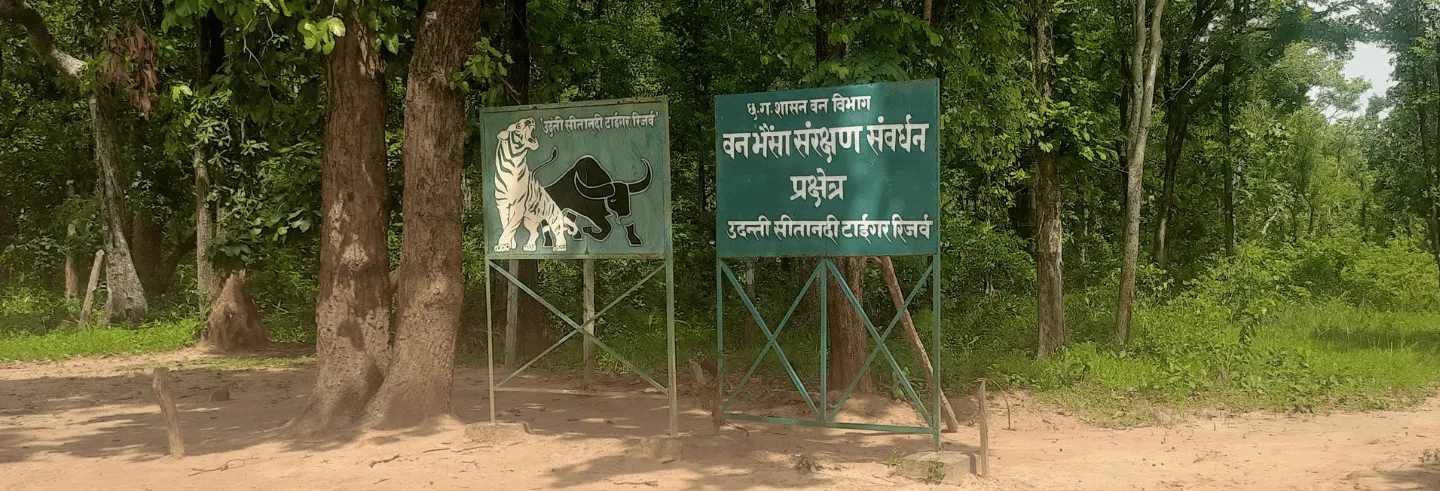During April, May, and June 2025, villagers in the Udanti-Sitanadi Tiger Reserve in Chhattisgarh received calls from the forest department about social media reports of tiger pugmarks being spotted and the animal being captured in trap cameras.
It had been more than two years since a tiger had last been spotted here, which explained the excitement of the forest officials. Udanti-Sitanadi is a low-density tiger zone. Tigers moving in naturally and choosing this region as their habitat implied the success of the vision to declare the area a tiger reserve.
The return of tigers in the region did not instil a fear of ‘man-eaters’ amongst the villagers of Udanti-Sitanadi. Their concerns were different. Ever since the reserve was set up in 2009 by the National Tiger Conservation Authority (NTCA), several villages in the core area have faced the threat of eviction. Any news of a tiger being spotted would heighten such threats. For the villagers, the news of sightings was a trick by forest officials to compel displacement.
A Conflict of Laws?
Villagers have long been opposing the tiger relocation plan in Udanti-Sitanadi. At the outset, this resistance appears to be on legal grounds and claims based on the Scheduled Tribes and Other Traditional Forest Dwellers (Recognition of Forest Rights) Act, 2006, commonly known as the Forest Rights Act (FRA), which ensures that the rights of forest dwellers over the forest precede the rights of all other stakeholders, including those of the forest departments. The usage of the term ‘historical injustice’ in the preamble of the FRA is seen to be demanding an emergent need to undo injustices. The friction between forest dwellers and forest officials over the evacuation plan, however, should be seen against the backdrop of the unusual social relations that took shape in the aftermath of the coming of the FRA.
Villagers see the relocation of tigers as a continuation of injustice, and read it as inducing a dual displacement, both of humans and tigers.
The sufferers of historical injustice are not merely humans living in the forest, but also include the animals in the wild. Villagers see the relocation of tigers as a continuation of injustice, and read it as inducing a dual displacement, both of humans and tigers. The rejection of the NCTA’s plan emerges from a cultural habitus which is threatened by the forced displacement of both humans and tigers. The relocated tigers are not part of the ‘local social’. Tigers and other felines, for the forest dwellers, are inhabitants of the forests where they are. By moving the tigers, the NTCA forces a specific kind of sociality that is not part of the villagers' traditional imagination.
The NTCA is tasked by the Wildlife Protection Act, 1972 to identify areas for tiger reserves and manage the feline population in different clusters. When the tiger population in a certain area grows beyond a point, there could be adverse effects on the landscape and a rise in conflicts with humans. Conservationists have devised mechanisms to disperse the tiger population to low-density zones where enough prey can be had, while keeping heed not to endanger species in the new location. Thus, the relocation of tigers to the Udanti-Sitanadi reserve from high tiger-density areas of Madhya Pradesh follows a scientifically approved method.
Yet, critical assessments of the tiger conservation project have raised concerns that the Ministry of Environment, Forest & Climate Change has been diverting forest land for tiger conservation at an unprecedented rate. The pace has quickened after the coming of the Forest Rights Act, which granted forest villages the rights to protect, manage, and conserve forests through Community Forest Resource Rights and Individual Forest Rights. CR Bijoy highlights that the ministry notified 31 tiger reserves in 2007—immediately after the enactment of the FRA—ring-fencing nearly 3 million hectares of land.
The NTCA was to have gone about its conservation efforts with the support of local communities, persuading them to opt for voluntary relocation. On the contrary, it has tried to impose a ban on the recognition of the rights of forest communities in what are termed Critical Tiger Habitats, by exploiting the ambiguity of guidelines for such habitats. As Ravi Chellam argues, this suggests that the environment ministry has not accepted the purpose and role of the act: of creating “more inclusive, participatory, democratic and just approaches and models of conservation”.
Unacquainted Beings
“Wherever the tiger lived, its cult enveloped people”, the wildlife expert Valmik Thapar (2025) reminds us. Human who share dwelling spaces with tigers have ample stories about their relationship with the forest and its non-human inhabitants. Anthropologist Annu Jalais (2014) talks of the ‘relatedness’ of humans and tigers in the Bengal Sundarbans through the legend of Bonbibi. The animosity between Bonbibi (a messenger of God) and Dukhe (incarnated as a tiger and claiming humans as prey) reaches a reconciliatory arrangement, with Bonbibi accepting Dukhe and other tigers as her brothers. Humans and tigers share the same food and claim the same forest.
In Udanti-Sitanadi, tigers are not part of the everyday narrative as in the Sundarbans. There is nothing peculiar about tigers that the villagers claim to know; if there ever was a knowledge of how to live with the tigers, it has long been lost. What the villagers now know is the difference between wild animals choosing their natural habitat, as opposed to being forced to choose a habitat. This knowledge has come out of their own experiences of leopards and wild buffalo.
The animals would give signs well in advance if they were going to take away someone [...] An animal attack was often the result of a transgression.
The notified region of Udanti-Sitanadi is inhabited primarily by the Gonds, Kamars, and Bhunjias, apart from other forest-dwelling communities. Kamars and Bhunjias are categorised as the Particularly Vulnerable Tribal Groups. There are similarities in the ways that Gonds and Kamars trace their gotra. One finds Netam and Sori (which means tiger) as gotra names among Gonds and Kamars. The arguments against the displacement and relocation of tigers are derived from the same rationale on which they voice their opposition against the displacement of humans. ‘The tigers are our brothers, like the Soris', they claim. ‘If we don’t want humans to be displaced, then we don’t want tigers to be displaced either’ is their argument.
Humans and animals have been living together in the forests of Udanti-Sitanadi for a very long time, and have grown to anticipate each other’s nature. Even though leopards are spotted occasionally, they do not haunt. Charan Netam of Dhaurabhata village in Dhamtari, a Kamar settlement of 7 households, knew that the animals would give signs well in advance if they were going to take away someone (or more usually, cattle). The villagers would spot pugmarks and see the animal at a distance, or near the river. An animal attack was often the result of a transgression, Charan felt. The year before, a leopard attacked a villager and took away and killed his five-year-old daughter. Charan saw it was a punishment for breaking a taboo of selling the new harvest of karyil (bamboo shoots) before performing the rituals of paura, when the new harvest is first offered to the deity Shitla Devi. Charan’s son, of a similar age to the girl, was licked by the leopard the same night, but was spared. It was the breach of custom on the part of the victim’s family, resulting in the transgression by the wild animal, Charan was clear.
The deity continued to be wrathful. A young ox was taken just a day before my conversation with him. Charan and the village priest Prakash Netam were planning to organise a ceremonial sacrifice to please the angered goddess and break the curse. Only then could old clothes from the victim’s family be thrown into the river to symbolise the cooling of the deity’s anger.
The anthropologist Nayanika Mathur (2016) recounts an incident from her fieldwork in an Uttarakhand village, where the return of a tiger brought back memories of horror. Quite to the contrary, the latest news of a tiger being spotted in Udanti-Sitanadi was taken rather calmly, as was the case with the member of a civil society organisation I was with when he received a call from a forest official to confirm the movement of the animal through his networks. One would seldom meet anyone in the region who has any memory of meeting a tiger in the forest. Harshika, a 5-year-old child, told me that she was afraid of elephants because she had seen a video of a pachyderm trampling upon people. She was also aware of threats from bears; they went for the skull. But when I asked if she was afraid of tigers, she was clueless about how this animal could harm her.
Despite the presence of wild animals, people still slept outside their huts in Dhaurabhata, located in the middle of the forest. For Charan, this was hardly unusual. "Animals eat only animals, and they don’t disturb us". However, sarkari jaanwar (‘government animals’) could attack anyone. By ‘government animal’, he meant predators earlier kept in enclosed spaces and then released into the forest. He made a distinction between ‘government animals’, who were aadamkhor (man-eaters), and ‘jungle animals’, which were desi jaanwar and did not unnecessarily harm anyone.
Sarkari jaanwar, in Charan’s formulation, explains Mathur’s (2019) question: what makes a big cat crooked? The offence is not of the animal, but stems from enforcement in the name of conservation. The uncertainty of which kind of animal, sarkari or desi, was roaming in the area made the villagers’ lives precarious. Charan’s daughter, who walked three kilometres every day to go to school, now had to be accompanied on her journey by one of her parents; the frequent spotting of boondi (pugmarks) was unsettling their lives.
"People need markets once in a while, but they need the forest daily".
The change of habitat mutates the nature of both humans and animals. Without displacement, cohabitation is possible. There are several Kamar settlements in the hills of Kulhadi Ghat of Gariaband district. Reckoning the difficulties these dwellers have in accessing markets and other conveniences, which usually takes them more than a day, the district collector decided to relocate the villagers of Tarajhar and bring them down from the hill. Similar measures were planned for Madaal as well. Between 2015 and 2017, several houses were built under the aegis of Pradhan Mantri Awaas Yojana, and people from these villages were brought to live in these houses. Initially, these houses were used as second homes. However, all of them were abandoned in a few months. Benipuri Goswami of Khoj, an NGO working in the region, said that "people need markets once in a while, but they need the forest daily". I was suddenly reminded of D.D. Kosambi’s description of the emergence of the category of ‘criminal tribes’ in colonial taxonomy: stripped of habitat, reduced to begging and stealing.
The displacement of people from Udanti-Sitanadi and relocation of tigers in the region is to be seen as what I call dual displacement. The displacement of the tiger and people being both Janus-faced and detrimental to each other and for each other. If tigers are brought to the region, villagers in the core area would be forced to evacuate. If they refused to evacuate, then blame for the disappearance of tigers would be on the villagers, in the same manner as happened earlier, when the region was a sanctuary for another endangered species.
The Wild Buffalo Project
In 2005, before Udanti-Sitanadi was notified as a tiger reserve, the Wildlife Trust of India and the Chhattisgarh government came together in 2005 to devise measures for the assessment and conservation of the wild buffalo (Bubalus arnee), an endangered species with less than 4,000 surviving individuals globally. The failure of that project is a lesson that keeps villagers in the region sceptical and wary of the tiger relocation plan.
If the number of tigers goes down, as happened in the wild buffalo case, the blame would be on the forest dwellers.
Arjun Nayak, a former sarpanch of a village in Udanti, could foresee a similar future for the tiger plan. “Would you like to see the lone survivor of the project? It has become very old, and one of its eyes has also been damaged as it keeps hitting the fencing because of solitude and anger”, he said. I was more than ready to see it. As we hopped on his motorcycle to reach the fenced area, Arjun narrated to me a brief history of the project.
As researchers and tourists flocked to Udanti from across the world, sanctuary officials got villagers to chase wild buffaloes from the forest towards visitors. The villagers would receive Rs 100 as prize money if they were successful in doing so. As the number of visitors grew, so did the plight of these bovines. Some of them died, whereas some ran away from the forest, leaving just one male buffalo in the protected area. Chhotu, as this buffalo was named, mated with a domestic female buffalo from the village. After the female buffalo gave birth to a male calf, the sanctuary officials relocated both of them to the sanctuary along with Chhotu. The female buffalo was named Asha and the calf was called Raja. Chhotu and Asha produced seven buffaloes between 2006 and 2019.

When we reached the protected area, an information board lying on the ground at the entrance provided details of the births and deaths of these bovines. It referred to Asha (who died in 2020) as a wild buffalo and listed the birth dates of all the calves except Raja. When DNA testing of the calves found that they were not of the Bubalus arnee species, they were let off in the forest. In my interaction with the villagers of Kathwa in Kulhadi Ghat, they complained that these buffaloes have descended from the Udanti to the Kulhadi Ghat region and have been ruining their crops.
As we reached the protected area, a guard entered the gate and chased Chhotu to the side of the fence I was standing; an action reminiscent of the story Arjun had narrated to me. I could very clearly see the damaged eye of the buffalo. He had very few years left to live, the guard said.
The wild buffalo project made Arjun doubtful of the efficiency of the forest department in conserving tigers. He was afraid that if the number of tigers goes down, as happened in the wild buffalo case, the blame would be on the forest dwellers. "We, the villagers, don’t see tigers. I have never seen a tiger in the forest in my life. How is it that the District Forest Officer, the Ranger, and the Deputy Ranger locate the tigers sitting from their offices in Gariaband" miles away, he wondered. He scoffed at news of tigers being spotted in the region; they were rumours aimed at instilling terror amongst the villagers of the core area. But if a tiger has naturally chosen the region as its habitat, then Arjun was clear that the forest department should immediately stop relocating animals from a different state.
Conclusions
The context of opposition to the tiger relocation plan by the villagers in Udanti-Sitanadi is a statist view of wildlife conservation, which sees the wildlife habitats to be constantly threatened by the presence of humans in their proximity. In this view, an area reserved for wild animals should constrain human dwellings and activities within its boundary to eliminate human-animal conflicts and create separate but safe habitats for all.
The divergence between the forest-dwelling communities and the NTCA in Udanti-Sitanadi does not pertain to any specific knowledge they have of tiger behaviour.
On 25 June 2025, in Dehradun, the union environment minister voiced his suspicion of accepting the eviction of people from the forest as a feasible model of conservation. He was speaking in favour of a view of forest management where scientific and indigenous knowledge come together. The synthesis of both the knowledge systems appears euphemistic. It puts a burden on the community to contribute its own knowledge, which may not be available. The divergence between the forest-dwelling communities and the NTCA in Udanti-Sitanadi does not pertain to any specific knowledge they have of tiger behaviour. It exemplifies the communities’ perception of historical injustice, based on their experience on the one hand, and the forest officials’ passive denial of it through scientific models of conservation, on the other. Although the forest-dwelling communities can list several experiences where forest officials can be seen to be inflicting injustice, there is seldom an acknowledgement from the officials rendering an act of their own as unjust. In the foreword of the report submitted by the Madhya Pradesh Task Force on Orange Areas in 2020, mandated to recommend a process for resolving disputes between the revenue department and the forest department relating to the orange areas, the additional chief secretary (forest), who is also the chairman of the task force, writes:
The preamble of the “Recognition of Forest Rights Act, 2006” clearly accepts that forest rights were not adequately recognized in the consolidation of state forests during the colonial period as well as in independent India resulting in historical injustice to the forest dwelling Scheduled Tribes and other traditional forest dwellers and has tried to rectify the situation. In that spirit, it is imperative that the efforts should be made even at this stage to rectify the errors made during the process of conversion of Malguzari forests into protected forests through the general notifications issued by the government. It will be unjust to prolong this injustice on one pretext or the other.
A view like this is welcome. But there must be a wider discussion on the contents of historical injustice. A more intensive list of historical injustice must be laid out. It cannot be done by justifying the actions of the forest department as scientific and having instrumental rationality to them. A re-envisioning of the human-forest relationship to undo injustice prompts the recirculation of traditions that were lost. How this relationship is going to shape up and contribute effectively to conservation will depend on how the ideals of conservation are visualised and democratised amicably for furthering the ideas of justice.
Sharib Zeya is a faculty member at Azim Premji University, Bhopal.









